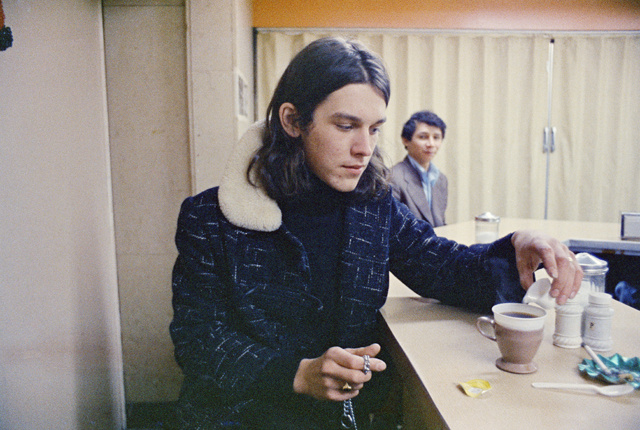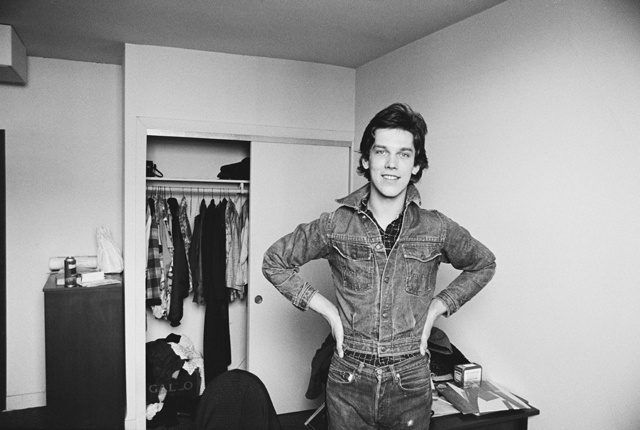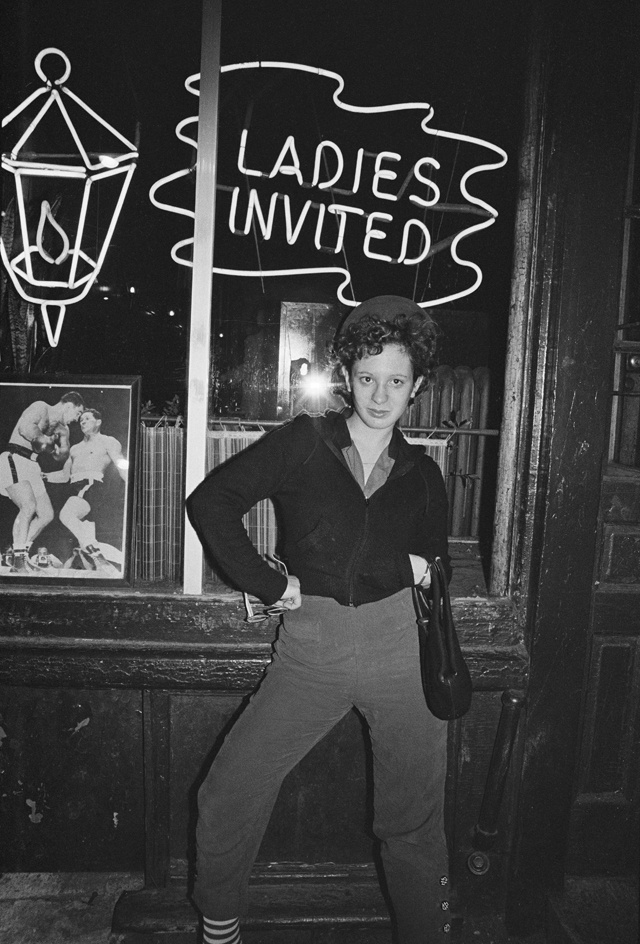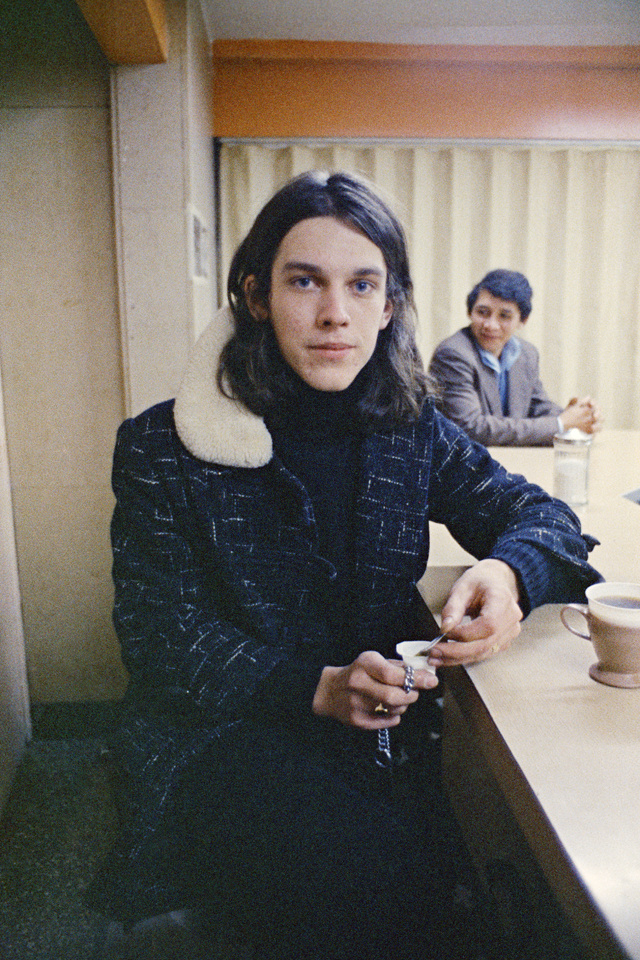![]()
Dictator Ceausescu on New Year’s Eve, 1976. Photo via Fototeca online a comunismului românesc. Collage: Mircea Topoleanu
According to a 2010 report carried out by the Romanian government's anti-discrimination agency, 84 percent of Romanians would refuse to drink from the same glass as a gay person. The country has a long history of being unfriendly to gays; in 1968, when dictator Nicolae Ceaușescu finally recognized that homosexuality existed, he immediately deemed it illegal. Throughout Ceaușescu's reign, the government persecuted same-sex couples by sentencing them to years of hard time in prison.
Abortions were declared illegal at about the same time, giving the regime the excuse they needed to raid people's privacy. According to a report conducted by Human Rights Watch, IGLHRC, and the LGBT NGO Accept, since 1970 communists used the anti-gay law to get rid of anyone they considered to be rebellious.
Understandably, this forced homosexuals underground, which made documenting human rights violations against them in Romania very difficult. These days, it’s hard to find gay people who lived through those times and are willing to talk about what happened. So, when Accept organized a meeting about Romania's gay history, I knew I had to go.
It was there that I met Daniel Iorga, one of the founders of Accept and a man who, in 1990, was the first person to ask for the dissolution of Article 200, the section of Romania's penal code that criminalized same-sex relationships. He told me all about what it was like to be gay in the 1980s. I also met a journalist, who did the same thing but preferred to remain anonymous.
VICE: How could you tell you were gay, if nobody knew what that was?
Daniel Iorga: People wouldn’t have known about it even if you asked. I figured out what was happening to me at 14, when I discovered The Book of Young Newlyweds in my house, in which they talked about birth, sexual relationships, and STDs. The last page was about sexual perversions, among which was homosexuality. The sentence that stood out to me was: “This is punished by jail time from one to five years.”
Anonymous: I heard about prison at 17. I went to a cinema, without knowing that it was a pickup spot. Some guy asked me to go to a small hotel, where he wanted to have sex. I didn’t “cooperate” with him, but I was dumb enough to ask the woman at the reception who the guy was (the receptionist had told me he was a recently released prisoner) so I went along in order to tell on him. I was a member of the Communist Party’s Youth Organization, so I felt like I was doing a good deed, an act of cleaning up society. I was lucky because the officer that was meant to handle the case was too busy to do so, and I eventually gave up on it, saving me from an act I would have regretted all my life.
![]()
Gabriel Popescu was the first male ballerina in the Romanian Opera, but he was forced to leave the country in 1959, after he was beaten up and accused of “sexual inversion.” He killed himself nine years later in London. Photo via
Was there anyone you could you speak to about your feelings?
Only to others “like us." If our friends or family found it, it would’ve been a disaster. For them it was something abominable. The first cure they would prescribe was a fast marriage, thinking that having children solved everything. I have some friends who went through this and leading a double life was hell. Another solution was to kick you out of the house. That still happens nowadays. Or they simply tell you that you need to see a shrink.
Daniel: I went to see a psychiatrist on my own. There were no psychologists or counselors back then; the schools training them had been closed down. There was nobody to talk to about this. How could you ever begin to tell your parents? What did they know? So I simply fell into depression.
How did the psychiatrist treat you?
He was a kind, elderly doctor. I told him I was frustrated, that I wanted to be different. He gave me a ton of antidepressants and sleeping pills and kept me in the hospital for over a month and a half. He suggested that I never think of being “different” again, that I read some books, that I study, and that I have fun with my friends—but he wouldn’t explain what was happening to me, because it was forbidden to talk about it. He couldn’t tell me whether it was good or bad. A year later, we repeated this treatment, after I went through another bout of depression.
Did being committed help?
Only in the sense that it helped me move on. I told my parents, and my mum cried for many weeks for the drama her child was going through. Dad wanted to take me to a prostitute, but I refused. I only got over the depression when I started having relationships. That's when I really understood what was happening to me.
![]()
The "Bermuda Triangle" of Bucharest
How did you go about finding sexual partners?
There was a public toilet in the main square of the city of Brasov, which was a cruising spot. Train stations and parks were also good for picking up dates. Most of the people you met refused to give their real names, because it was too risky.
Anonymous: In Bucharest we had the Bermuda Triangle, formed out of three public toilets in the middle of the city. Those who wanted to hook up walked this triangle a few times a day. People also hooked up at the train station, at the opera, and around Cișmigiu Park. At the Opera, the theaters, and at exhibitions, you would meet more "high-class" people—those who didn’t frequent the parks and the toilets. There were also circles of gay intellectuals, artists, and writers, who saw each other in a more intimate circle, into which you could get only if somebody brought you in, after you had won their trust. There were parties and… canasta nights, usually followed by “games” in the bedroom.
I've heard people hooked up at the seaside a lot.
It was paradise. In the seaside town of Mamaia, near a hotel called Dorna, there was a tanning salon where we all became nudists. Gays throughout the country went there, as well as tourists from other socialist countries—mostly Germans, Hungarians, and Czechs. You felt safe knowing the other guy was not from the same city or country as you.
So there were gay people who were out of the closet?
Mița Baston, a doctor specializing in rectal surgery, had his back covered. His dad was one of the doctors in the Central Committee of the Communist Party. His mom had allowed him to wear a dress in high school and college. At the hospital where he worked everyone knew he was queer. He was effeminate, bright, colorful, and it was a pleasure talking with him in private, but it was good not to be seen walking with him on the street.
How did you manage to stay out of the military police's way?
Daniel: I had proof from the hospital that I tried to get help. Plus, you weren’t punished for being gay, but for having sexual relations with a person of the same sex. And nobody could give my name to the officers of the militia, because I only had flings in other towns.
Anonymous: I was called into the police station once. A student had been denounced and when they searched his house, they found a notebook with the names of all the guys he banged, along with their phone numbers. Plus, he had them arranged by social status: students, officers, professors etc. I denied having sex with him and said I knew him through work. But at that time I thought of suicide, too, because if I had been found out there, it would have all been over. I would have been fired, thrown out of the party, and possibly my home.
What was the interrogation like?
There were two interviews: one with a nice cop and one with a bad cop, but I was lucky to only go through the first one. That officer was also a psychologist and told me he wanted information on “the phenomenon”—that he was looking to make a report to prove that gay people were not hurting the state, that they exist in all layers of society, and that some of them are valuable citizens.
He tried to convince me he was working in support of gay rights. He showed me some pictures—some were from documents, others were from stakeouts—so I could identify other gays, who they could pick up from the public toilets of Bucharest after the undercover officers hooked up with them. I denied knowing anyone.
![]()
Lesbianism was easier to hide, because most women were married young. But there were cases, even after the fall of the regime, when women of another sexual orientation were persecuted, hunted, and jailed.
Did denying anything helped?
Not at all. They only needed two denouncements to put you in jail. When they wanted to blackmail you for not cooperating or when they wanted to stop your career, to hurt you, they convinced two gays to say they slept with you, even if it wasn’t true. The ones who denounced you didn’t have to go to jail. At the end of the interrogation the bad cop showed up and said, “Alright, if he won’t cooperate, I’ll take care of him,” and I knew what would happen. The student who denounced me was brought to confront me—I could see he had been tortured.
Did they beat you up?
No, but they called me into the precinct for a year, once every few months. Their interest waned after a certain point though, I don’t know why. Investigations would sometimes end because they led to somebody very high up in his field, some party leader or somebody’s son. The student who denounced me was sent to prison, though.
What happened to those who were sent to jail?
They sat in a cell with common prisoners. The warden made it clear what they were sentenced for and… they became a lightning rod for all the other prisoners. Basically, you were dead if they found out you were gay. I have friends who went through it, and were traumatized by it; they left the country and never came back.
Daniel: With this method the police were trying to gather informants: "Want to be let go? Then you have to work for us." It was an ideal blackmail method, because it was hard to choose jail over being an informant.
What happened to these people after they were released from prison?
Anonymous: They had to start from nothing. Their families didn’t want anything to have to do with them. And with a police record like this you could never have a career.
Daniel: A friend of mine who was a math teacher did two and a half years and when he got out, he had to work as the doorman at a hospital. He had a degree in economics. Then he sold his house, moved to another city, and got a job as an economist. It was OK, but he had to work for it.
![]()
Nicolae Ceaușescu, his wife Elena, and their favorite son, Nicu, at the dictator’s birthday 26 January 1980. Photo via Fototeca online a comunismului românesc
In most of Europe, sexual orientation wasn’t punished with prison time. Why was the Ceaușescu government so inflexible on this subject?
Anonymous: After the Revolution, people started saying that his homophobia was meant to hide some homosexual adventures of his own from his youth, when he was only a young apprentice recruited by the communists. Some spoke of a relationship with one of the founders of the Communist Party, others say that while he was imprisoned at Doftana he had relationships with the other communist dictator, Dej. But none of this was proven. For all his dreams of a new man, homosexuality had no room in his social scheme.
Elena Ceaușescu, his wife, was very passionate about stories from the homosexual scene, isn't that right?
Daniel: Stories of sex in general. Former general Pacepa writes in his memoir that she had placed microphones in the houses of the members of the Central Committee of the Party so she could know all about their sexual exploits. There was also a story about their eldest son, Valentin—he had a suspicious friendship with a gay actor named Doru Popescu, who in the end was forced to leave the country. Their friendship was known in the press and art scenes. Elena found out and to protect her boy she made a passport for the actor, sent him to France, and forbade him to return.
But it was also about the influence the Russians had on Ceaușescu.
Yes. They also put you in prison. The Poles, Czechs, Hungarians and Bulgarians also belonged to the Russians but they all eliminated the article incriminating same-sex relationships in 1968. Even Boris Yeltsin removed the Russian one in 1992. Romania, on the other hand, increased the punishment to somewhere between two and seven years in 1997 and outlawed gay “propaganda." The European Council forced us to eliminate the sentence, but the other article was only removed in 2001, which only happened so we could get into the EU and NATO.





















































